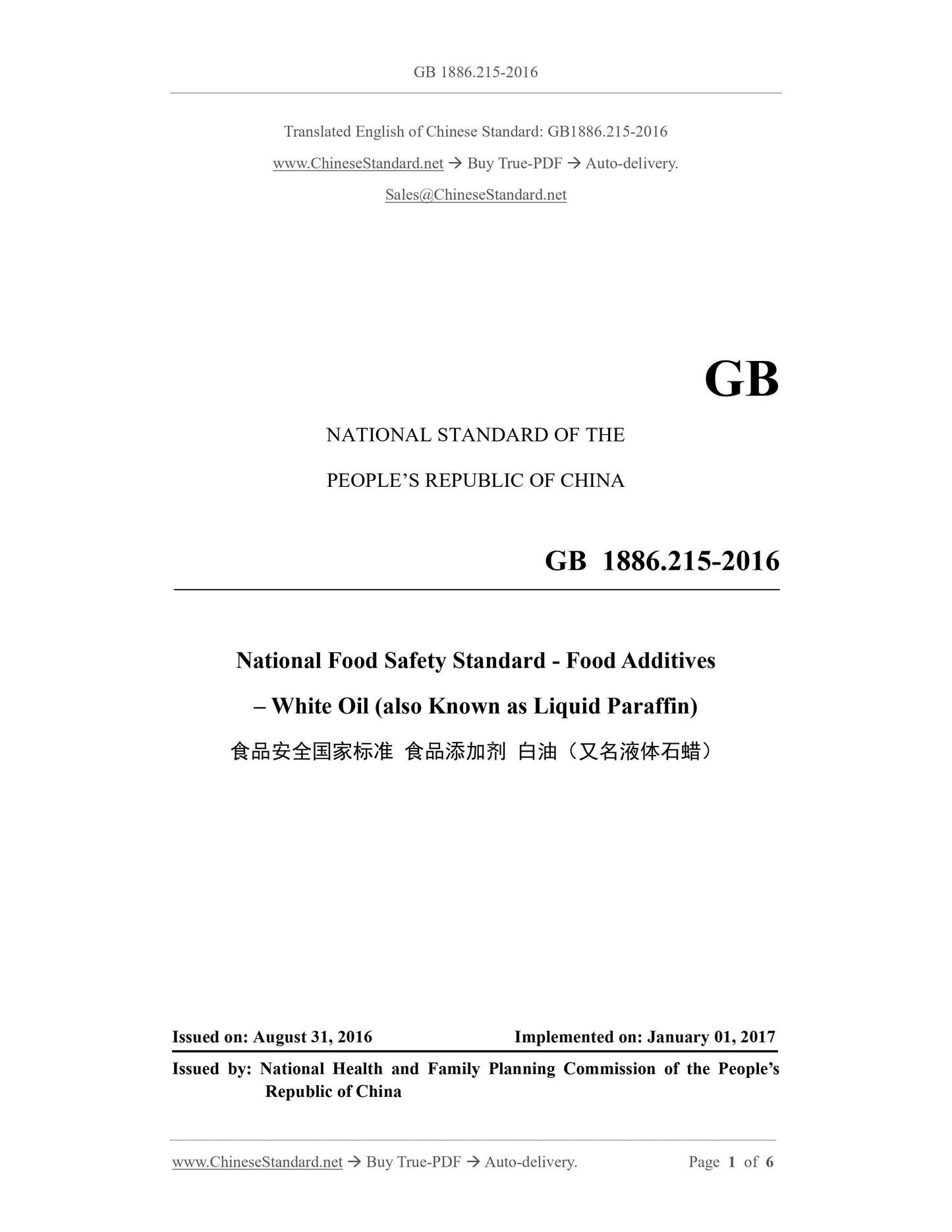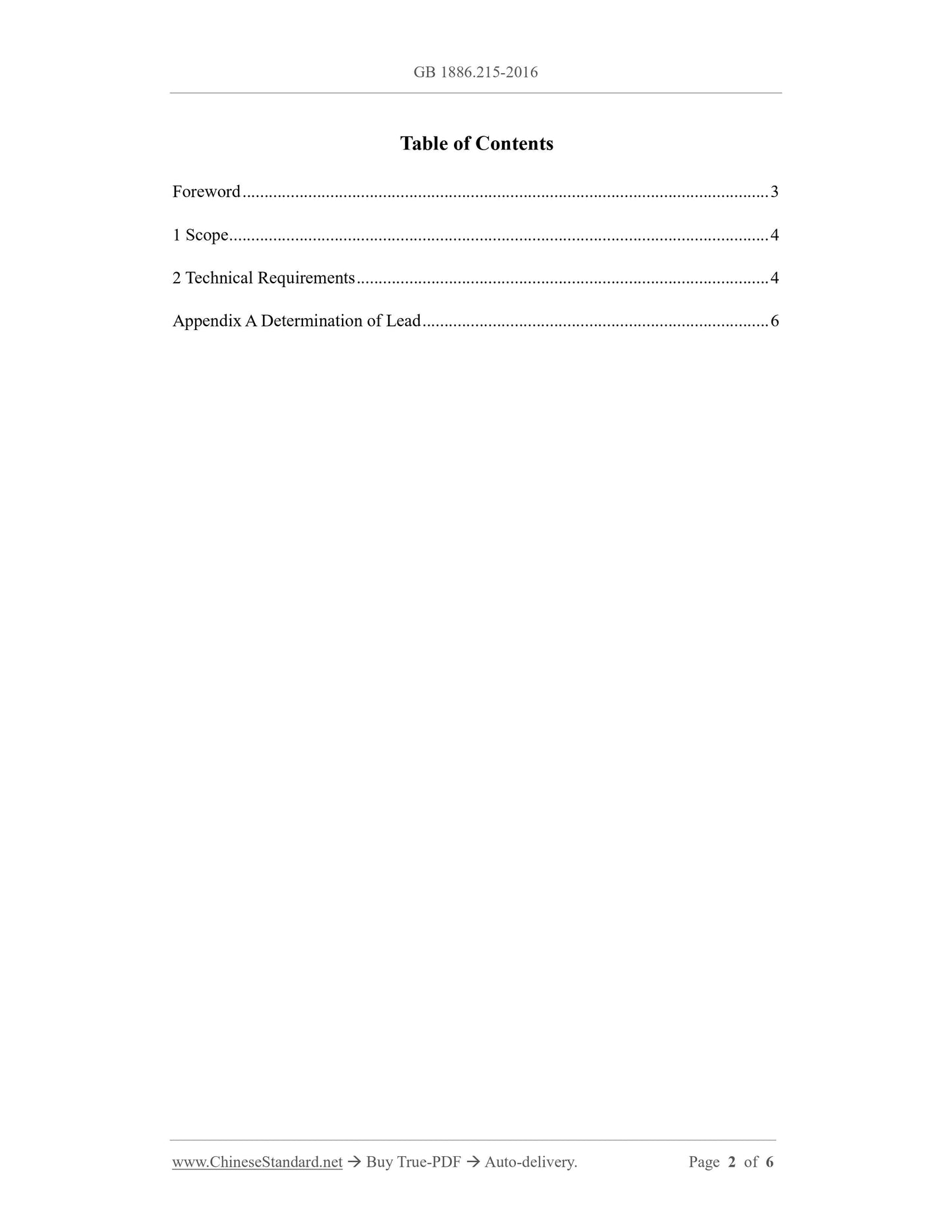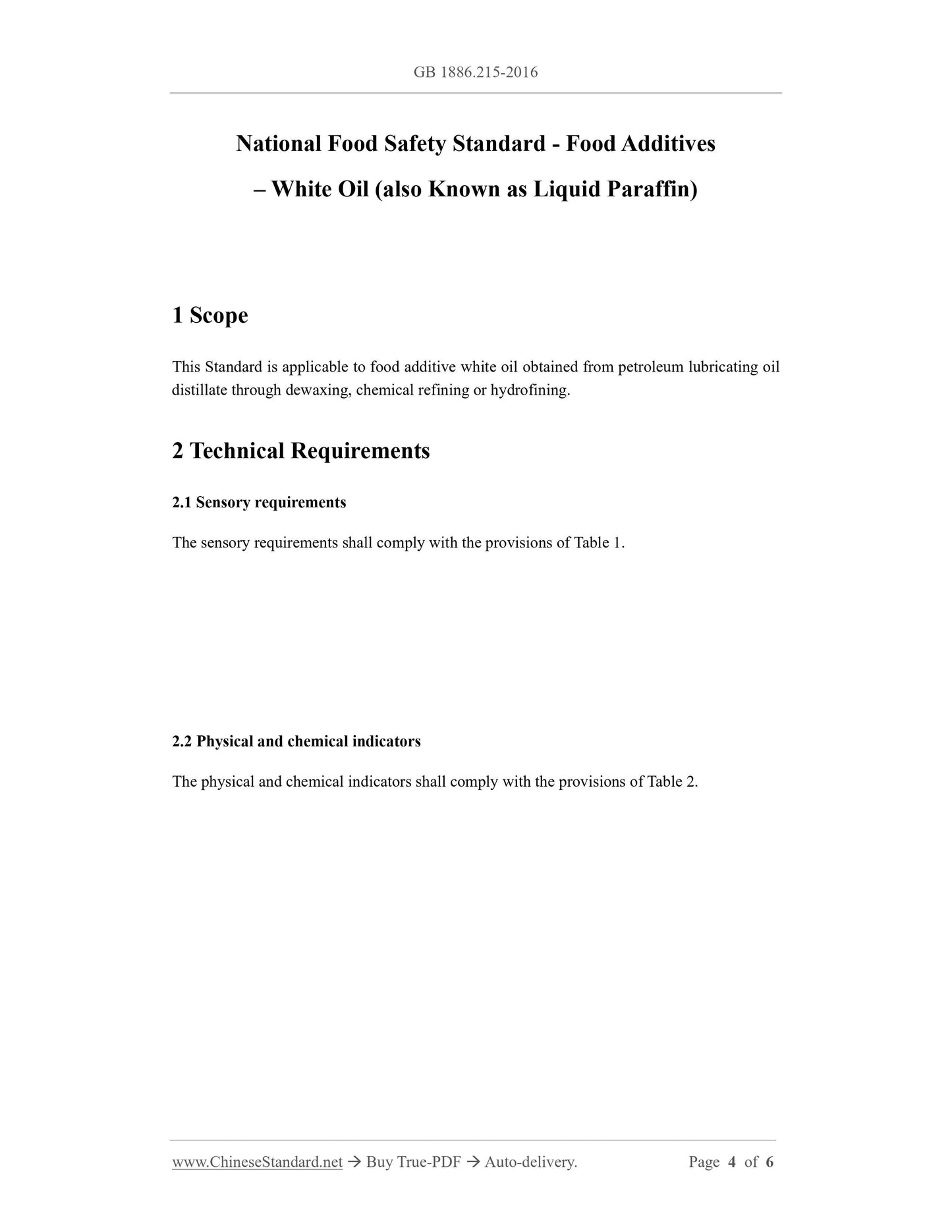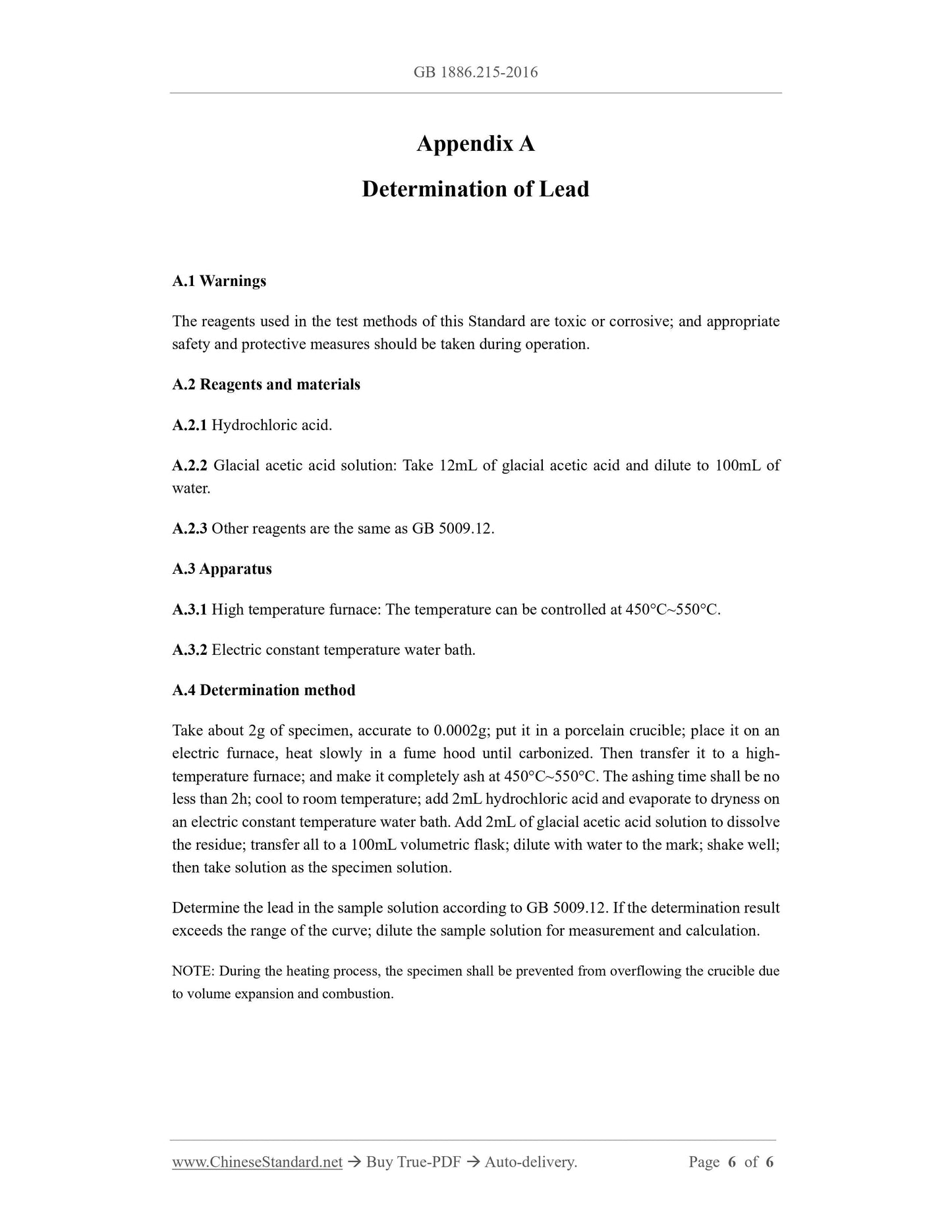1
/
of
4
PayPal, credit cards. Download editable-PDF & invoice In 1 second!
GB 1886.215-2016 English PDF (GB1886.215-2016)
GB 1886.215-2016 English PDF (GB1886.215-2016)
Regular price
$70.00 USD
Regular price
Sale price
$70.00 USD
Unit price
/
per
Shipping calculated at checkout.
Couldn't load pickup availability
Delivery: 3 seconds. Download true-PDF + Invoice.
Get QUOTATION in 1-minute: Click GB 1886.215-2016
Historical versions: GB 1886.215-2016
Preview True-PDF (Reload/Scroll if blank)
GB 1886.215-2016: Food grade white oil
GB 1886.215-2016
GB
NATIONAL STANDARD OF THE
PEOPLE’S REPUBLIC OF CHINA
National Food Safety Standard - Food Additives
– White Oil (also Known as Liquid Paraffin)
ISSUED ON: AUGUST 31, 2016
IMPLEMENTED ON: JANUARY 01, 2017
Issued by: National Health and Family Planning Commission of the People’s
Republic of China
Table of Contents
Foreword ... 3
1 Scope ... 4
2 Technical Requirements ... 4
Appendix A Determination of Lead ... 6
National Food Safety Standard - Food Additives
– White Oil (also Known as Liquid Paraffin)
1 Scope
This Standard is applicable to food additive white oil obtained from petroleum lubricating oil
distillate through dewaxing, chemical refining or hydrofining.
2 Technical Requirements
2.1 Sensory requirements
The sensory requirements shall comply with the provisions of Table 1.
2.2 Physical and chemical indicators
The physical and chemical indicators shall comply with the provisions of Table 2.
Appendix A
Determination of Lead
A.1 Warnings
The reagents used in the test methods of this Standard are toxic or corrosive; and appropriate
safety and protective measures should be taken during operation.
A.2 Reagents and materials
A.2.1 Hydrochloric acid.
A.2.2 Glacial acetic acid solution: Take 12mL of glacial acetic acid and dilute to 100mL of
water.
A.2.3 Other reagents are the same as GB 5009.12.
A.3 Apparatus
A.3.1 High temperature furnace: The temperature can be controlled at 450°C~550°C.
A.3.2 Electric constant temperature water bath.
A.4 Determination method
Take about 2g of specimen, accurate to 0.0002g; put it in a porcelain crucible; place it on an
electric furnace, heat slowly in a fume hood until carbonized. Then transfer it to a high-
temperature furnace; and make it completely ash at 450°C~550°C. The ashing time shall be no
less than 2h; cool to room temperature; add 2mL hydrochloric acid and evaporate to dryness on
an electric constant temperature water bath. Add 2mL of glacial acetic acid solution to dissolve
the residue; transfer all to a 100mL volumetric flask; dilute with water to the mark; shake well;
then take solution as the specimen solution.
Determine the lead in the sample solution according to GB 5009.12. If the determination result
exceeds the range of the curve; dilute the sample solution for measurement and calculation.
NOTE: During the heating process, the specimen shall be prevented from overflowing the crucible due
to volume expansion and combustion.
Get QUOTATION in 1-minute: Click GB 1886.215-2016
Historical versions: GB 1886.215-2016
Preview True-PDF (Reload/Scroll if blank)
GB 1886.215-2016: Food grade white oil
GB 1886.215-2016
GB
NATIONAL STANDARD OF THE
PEOPLE’S REPUBLIC OF CHINA
National Food Safety Standard - Food Additives
– White Oil (also Known as Liquid Paraffin)
ISSUED ON: AUGUST 31, 2016
IMPLEMENTED ON: JANUARY 01, 2017
Issued by: National Health and Family Planning Commission of the People’s
Republic of China
Table of Contents
Foreword ... 3
1 Scope ... 4
2 Technical Requirements ... 4
Appendix A Determination of Lead ... 6
National Food Safety Standard - Food Additives
– White Oil (also Known as Liquid Paraffin)
1 Scope
This Standard is applicable to food additive white oil obtained from petroleum lubricating oil
distillate through dewaxing, chemical refining or hydrofining.
2 Technical Requirements
2.1 Sensory requirements
The sensory requirements shall comply with the provisions of Table 1.
2.2 Physical and chemical indicators
The physical and chemical indicators shall comply with the provisions of Table 2.
Appendix A
Determination of Lead
A.1 Warnings
The reagents used in the test methods of this Standard are toxic or corrosive; and appropriate
safety and protective measures should be taken during operation.
A.2 Reagents and materials
A.2.1 Hydrochloric acid.
A.2.2 Glacial acetic acid solution: Take 12mL of glacial acetic acid and dilute to 100mL of
water.
A.2.3 Other reagents are the same as GB 5009.12.
A.3 Apparatus
A.3.1 High temperature furnace: The temperature can be controlled at 450°C~550°C.
A.3.2 Electric constant temperature water bath.
A.4 Determination method
Take about 2g of specimen, accurate to 0.0002g; put it in a porcelain crucible; place it on an
electric furnace, heat slowly in a fume hood until carbonized. Then transfer it to a high-
temperature furnace; and make it completely ash at 450°C~550°C. The ashing time shall be no
less than 2h; cool to room temperature; add 2mL hydrochloric acid and evaporate to dryness on
an electric constant temperature water bath. Add 2mL of glacial acetic acid solution to dissolve
the residue; transfer all to a 100mL volumetric flask; dilute with water to the mark; shake well;
then take solution as the specimen solution.
Determine the lead in the sample solution according to GB 5009.12. If the determination result
exceeds the range of the curve; dilute the sample solution for measurement and calculation.
NOTE: During the heating process, the specimen shall be prevented from overflowing the crucible due
to volume expansion and combustion.
Share








